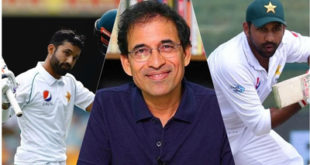India and Pakistan currently dominate all three International Cricket Council (ICC) Team Rankings, with the Men in Blue sitting atop the Test and ODI listings and their arch-rivals heading the T20 index.
However, the ICC rankings lack a major component that considerably discredits its working mechanism: there is no added weightage given to an away win.
It gives the same value or points to an Australian win against India in Melbourne as it would if Australia triumphed in Delhi. Even a cricketing novice would know how different the two wins are from each other.
Home advantage applies across the spectrum of almost all sports and the levels they are played at — be it a match in your own backyard, school or city; be it football, basketball, or individual sports such as tennis and snooker.
The only sport where home advantage hasn’t yet had any or much effect is perhaps mixed martial arts. That’s the exception rather than the rule though.
More often than not, the home team or player tends to capitalise on the advantage. A consecutive unbeaten streak at home is a common sporting phenomenon, and turning your own backyard into an impenetrable stronghold is an integral part of sporting imperialism.
But what creates this stark contrast between performances at home and away?
A grasp on the surface of play, familiarity with the air, acquaintance with the environment, the home crowd’s support, and even the comfort of changing in one’s own dressing room could be some factors that can influence performance.
Although degrees of separation vary across the board, there are certain sports that have more dynamic variables than the others.
In Formula One, for instance, the car you drive pre-determines the position you ought to be fighting for. In tennis, the surface is crucial to the gameplay you adopt and the trophies you stack. However, battles in table tennis and squash are fought on a more even keel, irrespective of the geographical location of the encounter.
Cricket in particular is a game of infinite autonomous variables.
The scorching sun of the Arabian Desert and the crumbling turf of the sub-continent are vastly different from cold English mornings and green-top pitches of the Oceanic Islands. Either way, these conditions are often alien to the people who venture across these dimensions, especially for the first time.
As a cricketer, the techniques you have learnt, the skills you have honed, the very foundations you have built your success on often come crashing down through a momentary awakening in a foreign space. When a Mitchell Johnson thunderbolt whizzes past your ear in Perth or Ashwin magic unfolds in front of your eyes in Nagpur, you realise it is something you never experienced in the habitat you were raised in.
Ricky Ponting averaged 12.28 runs in his first eight Test matches in India. Virat Kohli averages 13.40 in England, where he has played five Tests.
To restore some pride, Ponting came back to India and scored four fifties and a hundred in the following six games. Virat, too, must be itching to go back to England later this year and set the record straight. These are men who despite their early horrors on foreign soil remain at the pinnacle of their sport.
Thus, like players, great teams too should be critically judged on their performances in games played away from their comfort-zone. It is a common notion that in recent times international cricket teams do not travel as well as they used to, and have built bulwarks on their own territories.
However, this conformity is not a new development. Good teams have always built fortresses at home, and have struggled abroad. But great teams are great no matter where or whom they play.
West Indies of the 1980s was arguably the most dominating modern day cricket team, closely rivalled by the Australian squad that emerged at the turn of the new millennium under Steve Waugh. These were outfits that walked into any stadium, against any opposition, believing that they were destined to dominate.
The 1990s were a glorious age for Pakistan cricket; the boys Imran Khan had groomed, blossomed into men, and world-beaters. India during the same decade won just one game (against then minnows Sri-Lanka) out of the embarrassing thirty-nine it played on their travels. Interestingly, at home though, India was still dubbed the final frontier. Something even the mighty Australians found hardest to conquer.
Between 2015 and 2017, India won an astonishing nine consecutive series with an incredible win/loss ratio of 21-2 — all won at home except for series in Sri Lanka and West Indies. Before that, between 2013 and 2015, India had lost four consecutive series against South Africa, New Zealand, England and Australia. In these four countries, India managed to win just a solitary Test match in thirteen outings.
The failure of the ICC ranking system to depict this wide gap between games played home and away indicates how far behind cricket still is on the evolutionary curve of the modern sporting world. There will soon be a time that will look back at this ranking formula with disdain. The power (less) corridors at the ICC just need to decide when they will take that inevitable next step in progression.
While Pakistan is an unpredictable team — just like the the T20 format they so love — the ascendance of India in ODI cricket is pure science. Their dominance in the 50-over format is no happenstance. And the swagger with which their ODI team walks out on the field, even in South Africa. is a testament to the well-built foundations.
Test cricket, however, is a more complex and difficult challenge. But if India has ever appeared ready to rule Test cricket, it is here, and now, under the leadership of its shinning star: Virat Kohli. India plays five Test matches in England this summer and another four Down Under later this year.
No matter how much India wins at home, it’s how they perform insider cricket’s oldest coliseums which will decide how history remembers this team.
I had often wondered why a sport with regulated pitches like football implements such big weightage on games played home and away. How much different could it be to play at Anfield than let’s say the Wembley Stadium? Why are the results so skewed in the favour of the home side? I got my answer when I first witnessed football frenzy in a stadium.
Some believe that when humans perform an act of worship or prayer, it emits spirit into the air and changes its environment. And when the same mantras are recited with mass collected consciousness, it has the power to perform miracles.
Sachin! Sachin! Sachin! The roar is loud and can be heard far and wide as India’s demigod walks out to bat. When one hundred thousand people scream your name in tandem, it radiates an energy that fuels the course that destiny opts to take. In that moment, the echo in the ground converts average men into gladiators, great men into legends and turns boys like Sachin into immortals. Home and Away!

 South Asian Gazette Worldwide News Work
South Asian Gazette Worldwide News Work



